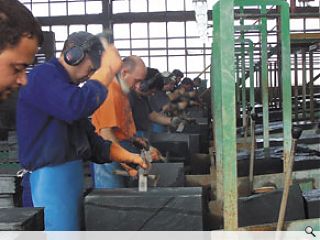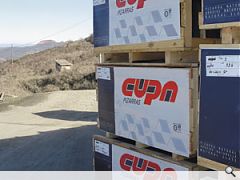Natural materials
6 Apr 2006
Penny Lewis was invited by the CUPA Group to visit its Piforsa quarry in northern Spain. The quarry is used to produce CUPA 3, a slate that is used widely in the Scottish market because of its looks and performance.
The Piforsa quarry is one of six CUPA quarries that sit on the hillside above the village of San Pedro. It is located on the border of the Ourense and Leon regions within a geological mass known as the Sinclinal de Truchas, an area that supplies 80 per cent of all the slate produce in Spain. To the north-east are the Picos mountains and Santander, to the west are Galicia and Santiago de Compestela. Some of the quarries have been mined since the 1890s. The villages in the area, like many Lakeland villages in the UK, are a picturesque and compelling advert for the durability and quality of slate as a roofing and more general construction material.
The nearest towns to San Pedro are Orense, Ponferrada and Leon. Ponferrada is a rapidly developing town; the periphery is littered with large new housing developments and the centre has its share of new retail outlets and hotels. In a relatively underdeveloped area of Spain the economy is clearly growing. CUPA is typical of the more successful players in this new economy. It is grounded in a traditional industry and uses highly skilled labour, but the group is not stuck in the past. CUPA is using modern techniques to review quality and to produce, package and market its product.
The CUPA Group was formed in the 1960s when a handful of small quarry-owning families in the San Pedro area joined together. Since then the business has grown significantly and extended into other areas. CUPA Pizarras (CUPA Natural Slates in the UK) is currently negotiating to buy four more quarries on land within the same geological seam and it owns a handful of other quarries in an adjoining valley. Today production has reached 140,000 tons per year.
Slate is extracted in large blocks using the diamond wire-cutting system and then the blocks are sawed into sizes that meet the customers’ needs before they are transformed into slates by highly skilled slate cutters or exfoliadores. The Piforsa quarry is used to produce CUPA Heavy 3, a 8mm-thick slate with a blue-black appearance and rough surface. It is designed for the Scottish market where CUPA is the number one supplier of new slates. The CUPA Heavy 3 provides a close match for traditional slates; it weathers well and has a natural life of about 100 years.
Demand for slate is increasing; it brings employment to rural areas and does no serious damage to the environment. There is a wide range of slates on the market supplied from across the globe; new slates are appearing from China, India and Brazil. It doesn’t seem to matter where the slate comes from, you can get good and bad slate from any country. The key issue seems to be quality control. Today the arguments are starker among the slate suppliers themselves. The UK market for slate is gently rising, Spanish slate’s share of that market was down slightly last year.
There is an ongoing debate about the qualities demanded by the new European standards, which appear to have dropped the standards expected. Many of the more professional slate producers prefer to use national standards, such as BS 680, the British standards, the Norme Francais, the French standards, or even the American standards which, on top of the usual criteria, measure the slate’s life expectancy.
The CUPA label identifies the slate, the quarry that it came from, the size and the number of slates, the standards reached according to British, French, Belgium and European standards and each pallet has a barcode and is signed by each packer. The company’s slogan is ‘calidad’ which means quality. “Good slate production relies heavily on quality control. As a general rule, 3 per cent of slate cut from the ground will end up as roofing slate, 80 per cent will be thrown away. The correct extraction and production of natural slate requires a great deal of investment,” says Lewis McNeice, CUPA’s marketing director.
CUPA has an in-house quality control and testing department to ensure that every slate meets standards ISO 9000/1200. In order to mark itself out from other slate producers it also offers traceability. There is a lot of low quality slate on the market today that is sold as top quality,” says McNeice. “What is important is that you can identify where the product came from and respond to the customers’ needs. The crates of slates record who packed the slates and who checked them. The company operates a ‘three strikes and you’re out’ policy towards packers that include poor slates in crates,” he adds.
Joan Walsh is an academic expert in slate and its performance. She has recently tested the performance of new Scottish slate from one of the Ballachulish and one of the Macduff quarries on behalf of the Scottish Stone Liaison Group, a body set up with support from the Scottish Executive to revive Scottish slate. She is also undertaking research for the DTI, looking at the life expectancy of a variety of internationally sourced slates in order to compare their performance with that of British slates.
“There is a greater appreciation of slate, which is good. It’s sad that there isn’t a source of Scottish slate; the last Scottish quarries at Easdale closed in the 1960s. We have a need for imported slate. It is sad that it has to come from as far away as China, but the real issue is not where it comes from but that we don’t accept rubbish. There is a tendency among some contractors to push the cheapest product; the cheapest is unlikely to be the best.” Poor slates fail for many reasons; some absorb too much water and crack and fail, others may fail due to a high carbonate content or the presence of vulnerable non-crystalline pyrite which may rust. If slates are not all sourced from the same geological source they may behave differently, which means roofs may have patches of slates in different colours or weather differently.
“The important thing is an appreciation of the variability of the material. That is why traceability is important,” says Walsh. Walsh looks at the chemical and physical properties of a slate in order to make predictions about its behaviour. “It is possible to measure small changes in mineralogy, microstructure or water absorption and relate these to the durability. The rate of increase in water absorption is one good measure of the performance of a slate.”
As part of her research Walsh has studied Spanish slate’s performance. “There is a wide variety of slates from Spain; some fail in a few months and others have a very good track record,” she says. “Some of the Spanish slates are very good, but they all have a reputation of being poor.” CUPA 3 Heavy, the slate that CUPA produces for the Scottish market, performed well in Walsh’s tests.
At present, one out of every four new slates used in the world comes from CUPA. The company would like to get to a position where one in every three slates is from its stock. Over time, the CUPA Group has diversified its interests.
The group is currently in the process of developing an export market for a number of new products including a timber insulated panel and an external paving system called Adoquina. In Spain the group sells petrol and bricks and provides engineering services. It has 1,300 employees, 900 of which are employed producing slates. Slate will always be at the heart of what the group does, but it is an ambitious company and there are proposals to float the company in 2011.
Read next: Scale
Read previous: Extension to the Barajas Airport, Madrid
Back to April 2006
Browse Features Archive
Search
News
For more news from the industry visit our News section.
Features & Reports
For more information from the industry visit our Features & Reports section.




